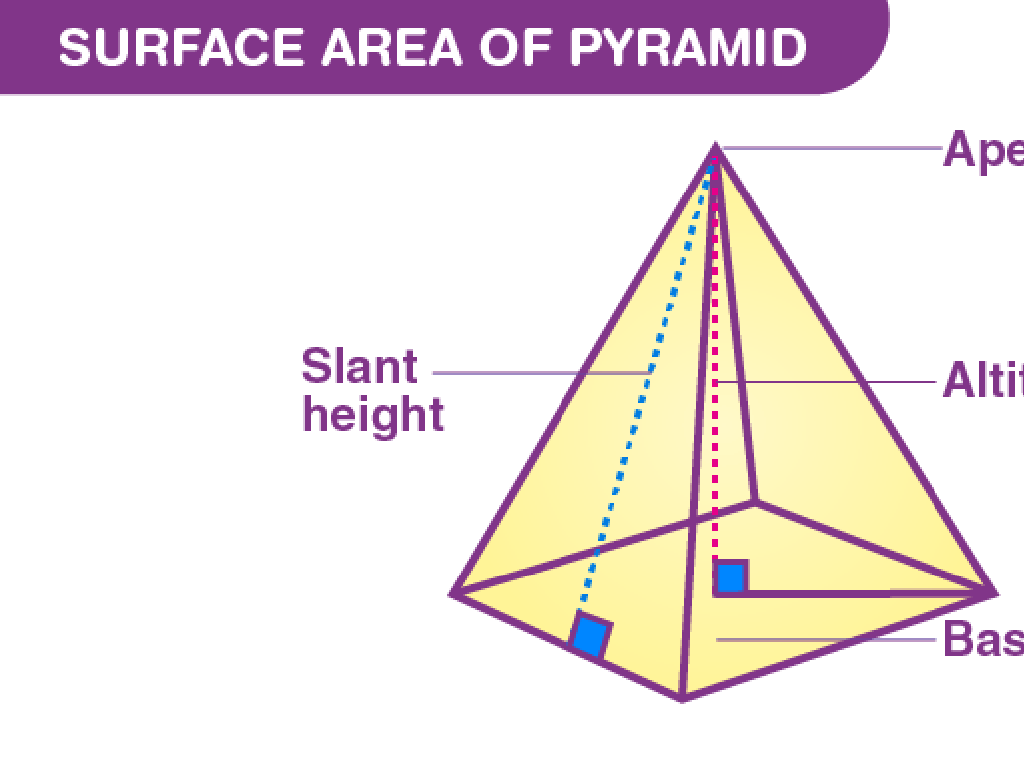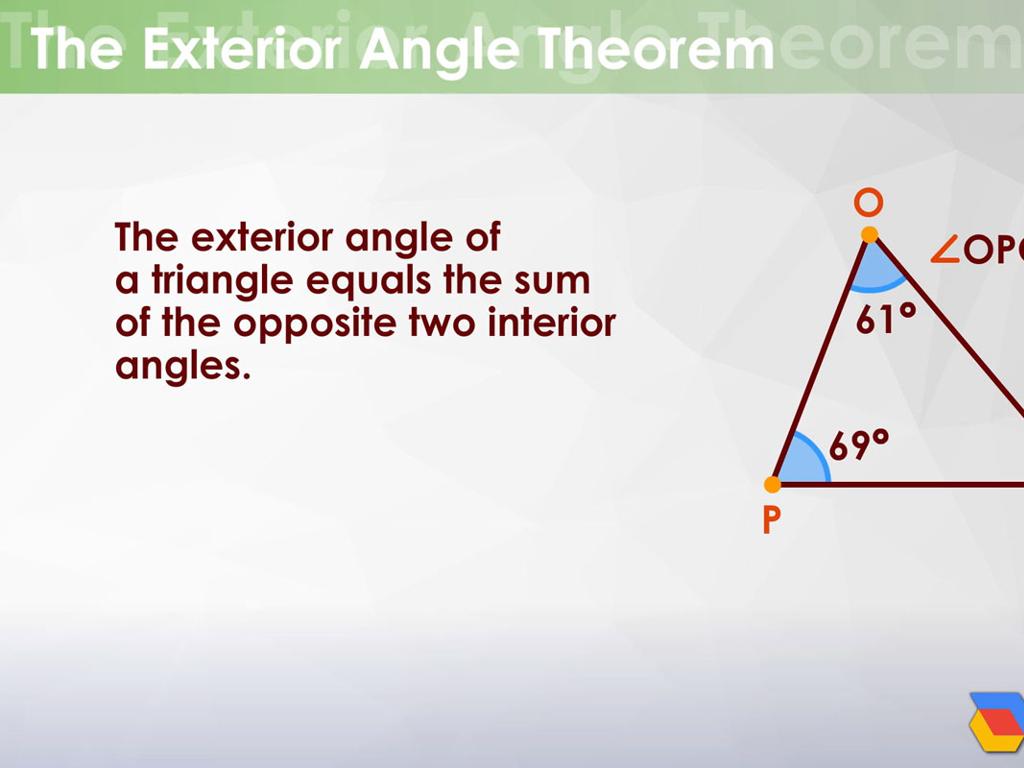Triangle Inequality
Subject: Math
Grade: Sixth grade
Topic: Two-Dimensional Figures
Please LOG IN to download the presentation. Access is available to registered users only.
View More Content
Exploring Triangle Inequality
– Basics of triangle inequality
– The sum of any two sides must be greater than the third side.
– Triangle sides must relate
– For example, in a triangle with sides 3 cm, 4 cm, and 5 cm, 3+4 > 5 and 3+5 > 4 and 4+5 > 3.
– Real-life applications
– Understanding this helps in fields like engineering and architecture.
– Ensuring safe structures
– It’s crucial for designing buildings, bridges, and other structures to ensure they are stable and safe.
|
This slide introduces the Triangle Inequality Theorem, a fundamental concept in geometry that applies to all triangles. Start by explaining that for any triangle, the lengths of any two sides added together must be greater than the length of the remaining side. This rule is essential for determining if three given line segments can form a triangle. Discuss how this theorem is not just a mathematical concept but also has practical applications in the real world, such as in engineering and architecture, where it is used to design safe and stable structures. Encourage students to think of examples where they might need to apply the triangle inequality theorem in their daily lives.
Exploring Triangles
– Define a triangle
– A shape with three sides and three angles
– Types of triangles
– Based on sides: equilateral, isosceles, scalene; angles: acute, obtuse, right
– Triangle properties
– Each angle sum is 180°; total side lengths vary
– Triangle inequality theorem
– The sum of lengths of any two sides must be greater than the third side
|
Begin the lesson by defining a triangle as a polygon with three edges and three vertices. Then, classify triangles based on their sides: equilateral (all sides equal), isosceles (two sides equal), and scalene (no sides equal); and based on their angles: acute (all angles less than 90°), obtuse (one angle greater than 90°), and right (one angle equal to 90°). Discuss the properties of triangles, emphasizing that the sum of the interior angles is always 180 degrees. Introduce the triangle inequality theorem, which states that in any triangle, the sum of the lengths of any two sides must be greater than the length of the remaining side. This is crucial for understanding why certain combinations of side lengths do not form a triangle. Provide examples and non-examples to illustrate this concept. Encourage students to think of real-life objects shaped like different types of triangles.
Exploring Triangle Inequality
– Triangle Inequality Theorem
– The sum of lengths of any two sides must be greater than the third side.
– Examples of valid side lengths
– For example, 3 cm, 4 cm, and 5 cm form a valid triangle.
– Understanding side length limits
– If the sum of two sides is less, they can’t meet to form a triangle.
– Explaining the theorem’s necessity
|
Introduce the Triangle Inequality Theorem, ensuring students understand that it’s a fundamental rule for constructing triangles. Provide clear examples of side lengths that satisfy the theorem, such as 3 cm, 4 cm, and 5 cm, which also relate to the Pythagorean triple. Explain that if the sum of any two sides is less than the third side, the sides cannot connect to form a triangle, which is why this theorem is essential in geometry. Encourage students to think of the theorem as a test to determine if three lengths can form a triangle. Use visuals or physical models to demonstrate this concept if possible.
Visualizing Triangle Inequality
– What is triangle inequality?
– The sum of any two sides must be greater than the third side.
– Can these lengths form a triangle?
– Examine if the sum of any two lengths is greater than the third.
– Activity: Build your own triangle
– Understanding with visual aids
– Use diagrams to show how different lengths can or cannot make a triangle.
|
This slide introduces the concept of triangle inequality to students, which is a fundamental principle in understanding the possible dimensions of a triangle. Start by explaining the rule that the sum of the lengths of any two sides of a triangle must be greater than the length of the third side. Provide visual examples with sets of lengths and ask students to determine if they can form a triangle. The activity involves students trying to create their own triangles using sticks or straws of different lengths, which will help them understand the concept practically. Use diagrams to visually demonstrate why certain sets of lengths do not meet the triangle inequality theorem and thus cannot form a triangle. This hands-on approach will help solidify the students’ understanding of the concept.
Triangle Inequality in Real Life
– Architects use triangle inequality
– Ensures designs are geometrically possible
– Triangle inequality in construction
– Critical for stable structures
– Real-world problem-solving
– Used to plan and execute projects
– Ensuring structural integrity
– Prevents collapse by verifying triangle sides
|
This slide aims to show students the practical applications of the triangle inequality theorem in everyday life, particularly in fields like architecture and engineering. Architects must consider the triangle inequality to ensure that their designs can actually be constructed. In construction, this concept is crucial for creating stable and safe structures. Real-world problem-solving often involves planning projects that require understanding of triangle relationships to ensure that elements fit together correctly. Emphasize the importance of triangle inequality in maintaining structural integrity, preventing potential failures in buildings and other constructions. Encourage students to think of examples where incorrect measurements could lead to unstable structures.
Let’s Practice Triangle Inequality!
– Solve triangle inequality problems
– Group activity: Possible third side
– Work together to find a range for the third side
– Challenge: Valid triangle lengths?
– Use given lengths to try forming a triangle
|
This slide is designed to engage students in hands-on practice with the triangle inequality theorem, which states that the sum of the lengths of any two sides of a triangle must be greater than the length of the remaining side. Start with individual practice problems to reinforce the concept. Move on to a collaborative group activity where students determine the possible lengths for the third side of a triangle given the other two sides. Finally, challenge students to apply their understanding by attempting to create triangles with specific side lengths, discussing why some sets of lengths do not form a triangle. Provide guidance and encourage students to explain their reasoning. Possible activities: 1) Using string to model triangle sides, 2) Drawing triangles on graph paper, 3) Comparing side lengths with playing cards, 4) Interactive whiteboard drag-and-drop exercise.
Class Activity: Exploring Triangle Inequality
– Gather sticks or straws of different lengths
– Attempt to form different triangles
– Observe triangle formation rules
– Not all stick combinations will make a triangle
– Discuss the triangle inequality theorem
– The sum of the lengths of any two sides must be greater than the length of the remaining side
|
This hands-on activity is designed to help students understand the triangle inequality theorem through experimentation. Provide students with sticks or straws of various lengths and instruct them to try to form triangles. They will discover that not all combinations of lengths will result in a triangle, illustrating the principle that the sum of the lengths of any two sides of a triangle must be greater than the length of the third side. After the activity, facilitate a discussion to reinforce the concept and ensure that students can articulate the triangle inequality theorem. Possible variations of the activity could include using different sets of materials, working in groups to compare findings, or challenging students to find the longest possible third side given two side lengths.
Triangle Inequality: Conclusion & Recap
– Review Triangle Inequality Theorem
– The sum of lengths of any two sides must be greater than the third side.
– Summarize today’s key points
– We explored how to apply this theorem to different triangles.
– Engage in Q&A session
– Time to ask questions and clarify doubts!
|
As we conclude today’s lesson on the Triangle Inequality Theorem, it’s important to revisit the main concept: in any triangle, the sum of the lengths of any two sides must be greater than the length of the remaining side. This is a fundamental rule in geometry that ensures the formation of a valid triangle. Summarize the key points discussed, including how to check for triangle inequality in various examples. Encourage students to ask questions to clear up any confusion. This Q&A session will help solidify their understanding and address any lingering uncertainties. Be prepared with additional examples in case students need further clarification and to demonstrate the theorem’s application in real-world scenarios.






